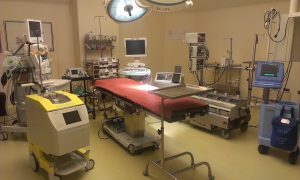Routine maintenance has been designed to operate continuously with proper maintenance procedures and periodical checking.
In order to ensure better performance and safety, routine maintenance should be performed.
How to sterilize the cable and Transducer?
Leads, sensors, and probes should be carefully checked for any signs of damage. Damaged leads should be replaced. Do not attempt to repair it.
Pressure domes and transducers should be carefully checked for any signs of damage. Special care should be taken to check the dome for cracks, and the transducer for a damaged diaphragm. Damaged items should be replaced.
All accessories must be cleaned before use.
The following precautions must be observed while cleaning and sterilizing of accessories.
Never boil or autoclave the vinyl jacketed lead wire.
The vinyl may be safely exposed to temperatures up to 100 C, but above 90°C, the vinyl softens and can be deformed permanently by mechanical stress. Handle gently when hot.
Cleaning cables and transducer
- ECG leads and sensors should be cleaned with a cloth slightly moistened with soapy water. Always allow the cable to dry thoroughly before use.
- Pressure domes and transducers should be cleaned to remove any foreign material from the membrane surface.
- Clean blood from all external surfaces.
- Carefully clean transducer with a gauze using a blood solvent. Avoid any pressure on the diaphragm.
- Clean the transducer leads with a cloth lightly moistened with soapy water. Always allow the cable to dry thoroughly before use.
Note
Frequent sterilization may discolor polycarbonate domes & reduce their life.
- Temperature sensors should always be cleaned as follows :
Sensors may be cleaned and disinfected by washing with 3% hydrogen peroxide or 70% isopropanol. Phenol disinfectants, such as hexachlorophene should be avoided because the disinfectant may be absorbed by the vinyl.
Warning for cleaning and sterilization
Do not use a sharp instrument for cleaning cables.
Do not use phenol based cleaners and never immerse cables in any liquid.
Avoid contact with strong, aromatic, chlorinated, ketone, ether or ester solvents. Prolonged immersion in alcohol or mild organic solvents, detergent solutions or highly alkaline solvents will cause the vinyl to lose its flexibility.
During cleaning or sterilization, sensors should be handled gently. While wiping it, hold the sensor in one hand at the tip and wipe the sensor and lead wire towards the plug end. If excessive pressure is used, the covering will be stretched, which may break the internal wires and destroy the probe.
Continued flexing of lead wires in use and during cleaning‘ will break the internal wires and cause failure. Failure due to this cause is not covered by manufacturer’s warranty.
